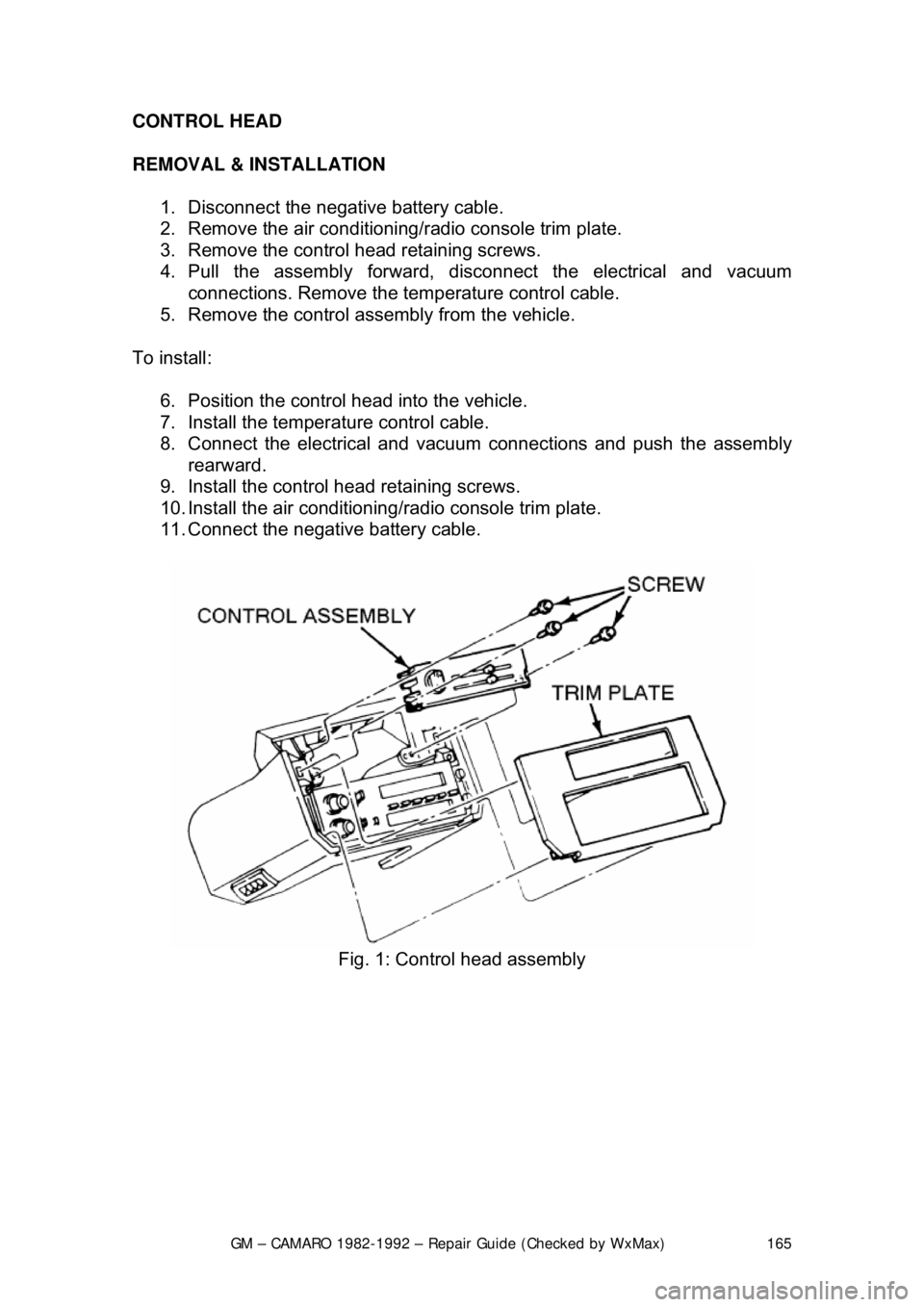1982 CHEVROLET CAMARO battery
[x] Cancel search: batteryPage 144 of 875

GM – CAMARO 1982-1992 – Repair Guide (Checked by WxMax) 144
1. Isolate the circuit from
the vehicle's power source.
2. Ensure that the ignition key is OFF when disconnecting any components
or the battery.
3. Where necessary, also isolate at least one side of the circuit to be
checked, in order to avoid reading parallel resistances. Parallel circuit
resistances will always give a lower reading than the actual resistance of
either of the branches.
4. Connect the meter leads to both sides of the circuit (wire or component)
and read the actual measured ohms on the meter scale. Make sure the
selector switch is set to the proper ohm scale for the circuit being tested,
to avoid misreading the oh mmeter test value.
WIRE AND CONNECTOR REPAIR
Almost anyone can replace damaged wires, as long as the proper tools and
parts are available. Wire and terminals ar e available to fit almost any need.
Even the specialized weatherproof, mol ded and hard shell connectors are now
available from aftermarket suppliers.
Be sure the ends of all the wires are fitted with t he proper terminal hardware
and connectors. Wrapping a wire around a stud is never a permanent solution
and will only cause trouble later. Repl ace wires one at a time to avoid
confusion. Always route wires exac tly the same as the factory.
If connector repair is necessary, only atte mpt it if you have the proper tools.
Weatherproof and hard shell con nectors require special tools to release the pins
inside the connector. Attempting to r epair these connectors with conventional
hand tools will damage them.
BATTERY CABLES
DISCONNECTING THE CABLES
When working on any electrical component on the vehicle, it is always a good
idea to disconnect the negative (-) battery cable. This will prevent potential
damage to many sensitive electrical co mponents such as the Engine Control
Module (ECM), radio, alternator, etc.
Any time you disengage the battery cables, it is recommended that you
disconnect the negative (&mdash) battery cable first. This will prevent your
accidentally grounding the positive (+) term inal to the body of the vehicle when
disconnecting it, thereby prevent ing damage to the above mentioned
components.
Before you disconnect the cable(s), first turn the ignition to the OFF position.
This will prevent a draw on the battery which could cause arcing (electricity
trying to ground itself to the body of a vehi cle, just like a spark plug jumping the
gap) and, of course, damaging some com ponents such as the alternator diodes.
Page 145 of 875

GM – CAMARO 1982-1992 – Repair Guide (Checked by WxMax) 145
When the battery cable(s) are reconnecte
d (negative cable last), be sure to
check that your lights, windshield wipers and other electrically operated safety
components are all working correctly. If your vehicle contains an Electronically
Tuned Radio (ETR), don't forget to also reset your radio stations. Ditto for the
clock.
Page 147 of 875

GM – CAMARO 1982-1992 – Repair Guide (Checked by WxMax) 147
SYSTEM OPERATION
The main portions of the SIR system
are the deployment loops and the
Diagnostic Energy Reserve Module (D ERM). The main function of the
deployment loops is to supply current through the inflator module(s), which will
cause deployment of the air bag(s) in t he event of a frontal crash of sufficient
force. The arming sensor, SIR coil assembly (driver side only), passen\
ger
inflator module jumper (passenger side only), inflator module(s), passenger
compartment discriminating sensor and fo rward discriminating sensor make up
the deployment loops.
The DERM has two functions. One to supply the deployment loops with a 36
volt reserve to ensure sufficient energy is available to deploy the airbag(s) if the
battery voltage feed to the arming sensor is lost during a frontal crash. Another
function is SIR electrical system diagnostics.
The arming sensor switches power to th e inflator module(s) on the high side
(power side) of the deployment loops. Ei ther of the discriminating sensors can
supply ground to the inflator module(s) on the low side (ground side) of the loop.
The inflator module(s) ar e only supplied sufficient cu rrent to deploy when the
arming sensor and at least one of the two discriminating sensors are closed
simultaneously.
SYSTEM COMPONENTS
DIAGNOSTIC ENERGY RESERVE MODULE
The DERM is designed to perform the following functions in the SIR system:
• Energy Reserve - Maintains 36 volt energy reserve(s) to provide
deployment energy when the vehicle volt age is low or lost in a frontal
impact
• Malfunction Detection - Performs diagnostic monitoring of the SIR
system electrical components
• Malfunction Recording - Provides diagnostic trouble code information
• Frontal Crash Recording - Record s the SIR system status during a
frontal crash
WARNING LAMP
The "INFL REST" or "AIR BAG" warning lamp is used to do the following:
• Verify lamp and DERM oper ation by flashing seven to nine times when
the ignition key is first turned ON
• Warn the driver of SIR electrical system faults which could potentially
affect the operation of the SIR system
• Provide diagnostic information by fl ashing the fault codes when the
diagnostic mode is enabled
Page 148 of 875

GM – CAMARO 1982-1992 – Repair Guide (Checked by WxMax) 148
ARMING SENSOR
The arming sensor is a protective switch
located in the power feed side of the
deployment loop. It is calibrated to clos e at low level velocity changes (lower
than the discriminating sens ors). This assures that the inflator module is
connected directly to the 36 volt output of the DERM or battery voltage feed
when either of the discrim inating sensors close.
DISCRIMINATING SENSORS
The discriminating sensors are wired in parallel on the ground side of the
deployment loop. These sensors are calib rated to close with velocity changes
which are severe enough to warrant deployment.
SIR COIL ASSEMBLY
The SIR coil assembly consists of two cu rrent carrying coils. They are attached
to the steering column and allow rotation of the steering wheel while maintaining
continuous contact of the deployment loop to the inflator module.
INFLATOR MODULES
Each inflator module consists of an inflat able bag and an inflator (a canister of
gas generating material with an initiati ng device). When the vehicle is in a
frontal crash of sufficient force, current flows through the deployment loops.
Current flowing through the initiator ignite s the material in the inflator module.
The gas produced from this reaction rapidly inflates the air bag.
Fig. 2: Forward discriminating se nsor location on 1990-1992 models
Page 149 of 875

GM – CAMARO 1982-1992 – Repair Guide (Checked by WxMax) 149
Fig. 3: Passenger com partment SIR component lo cations on 1990-1992 models
SERVICE PRECAUTIONS
The DERM can maintain sufficient volt age to cause a deployment for up to 10
minutes after the ignition switch is tur ned OFF or the battery is disconnected.
Always disable the system when perfo rming service procedures ON OR NEAR
the system and it's components.
CAUTION - The disarming and arming procedures must be followed in the
order listed to temporarily disable the SI R system. Failure to do so could result
in possible air bag deployment, pers onal injury or otherwise unneeded SIR
system repairs.
DISARMING THE SYSTEM
1. Turn the steering wheel so that t he vehicle's wheels are pointing straight
ahead.
2. Turn the ignition switch to the LOCK position.
3. Remove the SIR or AIR BAG fuse from the fuse panel.
4. Remove the left side trim panel, t hen remove the Connector Position
Assurance (CPA) device and disconnec t the yellow two-way SIR harness
connector at the base of the steering column.
5. On vehicles with passenger side air bags, remove the glove box door
then disconnect the yellow two-way c onnector located near the yellow
24-way DERM harness connector.
With the fuse removed and the ignition sw itch ON, the air bag warning lamp will
be on. This is normal and does not indicate a SIR system malfunction.
Page 151 of 875

GM – CAMARO 1982-1992 – Repair Guide (Checked by WxMax) 151
ARMING THE SYSTEM
1. Turn the ignition key to the LO CK position and remove the key.
2. On vehicles with a passenger side ai r bag, reconnect the yellow two-way
connector assembly located near the yellow 24-way DERM harness
connector. Install the glov e box door assembly.
3. Connect the yellow two-way connector assembly at the base of the
steering column.
Always be sure to reinstall the Connec tor Position Assurance (CPA) device.
4. Install the left side trim panel and rein stall the fuse in the fuse block.
5. Turn the ignition key to the RUN posit ion and verify that the warning lamp
flashes seven to nine times and then turn s OFF. If it does not operate as
described, have the system repair ed by a qualified technician.
HEATING AND AIR CONDITIONING
BLOWER MOTOR
REMOVAL & INSTALLATION 1. Disconnect the negative battery cable. If necessary, remove the diagonal
fender brace at the right rear corner of the engine compartment to gain
access to the blower motor.
2. Disconnect the electrical wiring fr om the blower motor. If equipped with
air conditioning, remove the blower relay and bracket as an assembly
and swing them aside.
3. Remove the blower motor cooling tube.
4. Remove the blower mo tor retaining screws.
5. Remove the blower motor and fan as an assembly from the case.
To install: 6. Position the blower motor into pl ace and install the retaining screws.
7. Install the blower motor cooling tube.
8. Connect all the electrical connections.
9. Connect the negative battery cable.
Page 165 of 875

GM – CAMARO 1982-1992 – Repair Guide (Checked by WxMax) 165
CONTROL HEAD
REMOVAL & INSTALLATION
1. Disconnect the negative battery cable.
2. Remove the air conditioning/ radio console trim plate.
3. Remove the control head retaining screws.
4. Pull the assembly forward, di sconnect the electrical and vacuum
connections. Remove the tem perature control cable.
5. Remove the control assembly from the vehicle.
To install: 6. Position the control head into the vehicle.
7. Install the temperat ure control cable.
8. Connect the electrical and vacuum connections and push the assembly rearward.
9. Install the control head retaining screws.
10. Install the air conditioning/ radio console trim plate.
11. Connect the negative battery cable.
Fig. 1: Control head assembly
Page 175 of 875

GM – CAMARO 1982-1992 – Repair Guide (Checked by WxMax) 175
CHAIN AND CABLE
CHAIN AT THROTTLE
1. Check for proper installation of cabl e assembly. Inspect the throttle; it
must be in the idle position.
2. Install the chain in the swivel so that the slack does not exceed
1/2 the
diameter of the ball stud.
3. Install the retainer on the swivel and make sure the throttle has not
moved from idle.
CHAIN AT SERVO 1. Check for proper installation of cabl e assembly. Inspect the throttle; it
must be in the idle position.
2. Install the cable on the third link of the chain; adjust the jam nuts of the
servo until there is no noticeab le slack in the chain.
3. Tighten the jam nuts and check that the throttle has not moved out of the
idle position.
MODULE
REMOVAL & INSTALLATION
1984-1992 MODELS
The module is mounted next to the heater and A/C duct on most models, but is
integral with the ECM on certain late-model engines.
1. Disconnect the negative battery cable.
2. Remove the right side sound insulator.
3. Remove the module attaching screws and remove the module.
4. Disconnect the electrical connector.
To install: 5. Connect the electrical connector.
6. Install the cruise control module and the attaching screws.
7. Install the right side sound insulator.
8. Connect the negative battery cable.